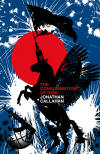The Consummation of Dirk
When I began to write this I suddenly realized that in order to review Jonathan Callahan’s debut collection of short stories, The Consummation of Dirk, I’d have to invent a whole new set of adjectives. The writing contained within these covers is imaginative, wrought, out-of-the-box, and perhaps bordering on the avant-garde, all of which have been said about many works of literature and which, in the long run, tell you little. Yet, while reading his stories, I had a sense of the traditional narrative undergoing a transformation—I pictured Bruce Banner changing into the Hulk. These are stories trying to punch their way out of the bag. They are written with some edge and share varying degrees of foreboding.
When I began to write this I suddenly realized that in order to review Jonathan Callahan’s debut collection of short stories, The Consummation of Dirk, I’d have to invent a whole new set of adjectives. The writing contained within these covers is imaginative, wrought, out-of-the-box, and perhaps bordering on the avant-garde, all of which have been said about many works of literature and which, in the long run, tell you little. Yet, while reading his stories, I had a sense of the traditional narrative undergoing a transformation—I pictured Bruce Banner changing into the Hulk. These are stories trying to punch their way out of the bag. They are written with some edge and share varying degrees of foreboding.
The title story is a collage portrait of Dirk Nowitzki, a pro basketball player whose career is apparently composed of letdowns and comebacks. Along the way, he has developed a sort of cult following. The portrait that emerges in this story is a 360-degree scan; we witness Dirk from all sides, including takes from former lovers, coaches, and Internet podcasts. My favorite is simply a marriage proposal in sky writing. Even Callahan enters the fray, allowing himself to be interviewed about the very book he has written about Nowitzki, The Consummation of Dirk. This is a mixture of fact and fiction that Callahan seems to favor in other of his stories. We watch as Dirk retreats from fame, looking for answers that are apparently not available. The final portrait of Dirk reminded me of those landscapes David Hockney created with his Polaroid camera, using dozens of single shots to make up a whole. Callahan has certainly Polaroided Dirk. The story left me a little dizzy.
Worth the price of admission is his story “Cymbalta.” Once again we have a mixture of possible fact and fiction. The narrator, possibly Callahan himself, is working in Fukuoka, Japan, as a teacher while trying to focus on his personal writing ambitions. We find our hero struggling with a drinking problem that is beginning to peak, and his prose reflects the frenetic paranoia that substance abuse episodes wreak on the psyche. Amidst this turmoil, the narrator has engaged novelist Rick Moody in an email correspondence asking for advice on his writing. Moody is encouraging. As the narrator’s life begins to unravel, he attempts to promote Moody from lit critic to “life coach.” The pace and quality of the narrator’s emails to Moody becomes frightening and obsessive and begins to approach the creepy borders of stalking. Next up is the deterioration of our narrator’s relationship with his fiancée. She says to him, “I’m telling you you need to get some help.” The narrator’s reply? “I’m taking the fucking Cymbalta!”
It’s a classic substance-addicted response, wanting to cure one drug problem by taking another drug, and you don’t know whether to laugh or cry. It reminded me of Jerry Stahl’s (of Permanent Midnight fame) attempt to cure his heroin addiction by switching to crack. Cymbalta aside, our hero begins to place all of his hopes on Rick Moody, life coach. Alone on Christmas Eve in a faraway country with his fiancée gone, he begins to wonder: “I started thinking about Rick. I wondered if he’d write me on Christmas Eve—how could he not—except the thought occurred to me I’d finally said too much.”
I began to wonder about Rick too. The story had the ring of a factual memoir, and I pondered where the fiction began and the reality stopped. Is it allowable to use real people in your fictional settings unless the fiction is a little too real? Tom Wolfe played with this in his books, such as The Electric Kool-Aid Acid Test (the prominent subject of the book, author and prankster Ken Kesey, said 98% of it was true). Of course the big-name public figures are always fair game, but what about our slightly lesser-known literary icons? Rick Moody politely declined to comment on this story, so I assume any gripe he may have had, if he had one, was worked out with the author. No writer was harmed in the creation of this story, and all ended well, I hope.
Regardless of whether he is blending autobiography and fiction or not, Callahan takes the reader in new directions with each story, and I will be curious to see where he ends up later in his career. I didn’t know what to expect when I began each new episode between these covers. If you are in the mood for such journeys, I suggest you give The Consummation of Dirk a try. Let’s hope his imagination never hits a wall.





